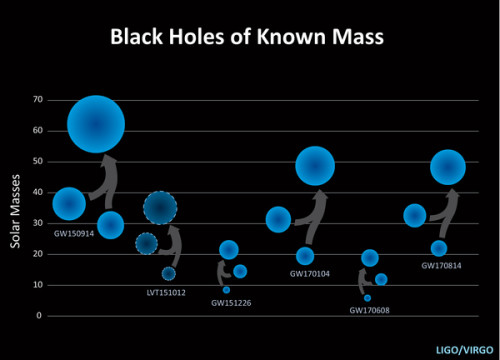
The other ones: five observed black-hole mergers, plus a possible merger shown with dashed outlines (Courtesy: LIGO)
By Hamish Johnston
They have done it again. Physicists working on the LIGO gravitational-wave detectors in the US have announced the observation of another black-hole merger.
This event was spotted on 8 June 2017 and involved two black holes combining to form a black hole 18 times more massive than the Sun. The Virgo detector in Italy did not see the event because it was not switched on. This is the fifth observation of gravitational waves from merging black holes seen by LIGO, which along with Virgo also detected a signal in August from the merger of two neutron stars. Unlike the neutron-star event, no electromagnetic radiation was seen from the merger.
The event involved black holes with masses seven and 12 times that of the Sun, making it the first time that LIGO has seen black holes of a similar size to those previously detected by X-ray astronomy.
The detection is described in a preprint on arXiv and a paper has been submitted to The Astrophysical Journal Letters.
There is much more about how LIGO and Virgo have revolutionized our view of the cosmos in Multimessenger Astronomy.
Guidelines
Show/hide formatting guidelines
this text was deletedwhere people live in harmony with nature and animals</q>
Some text